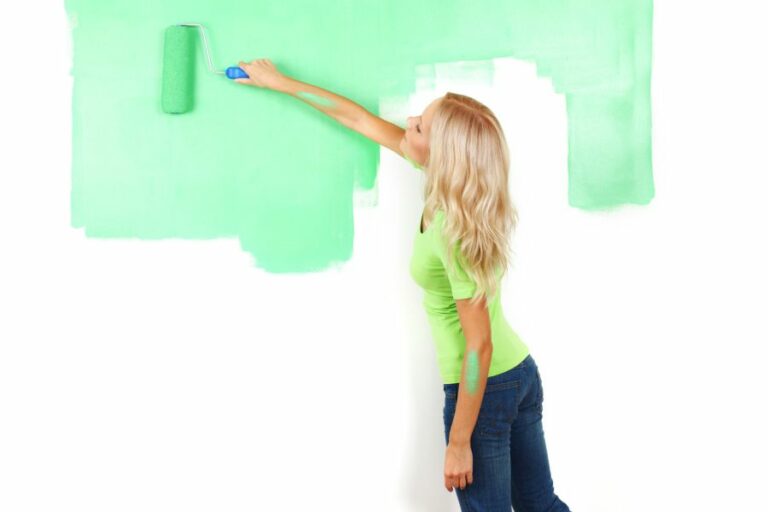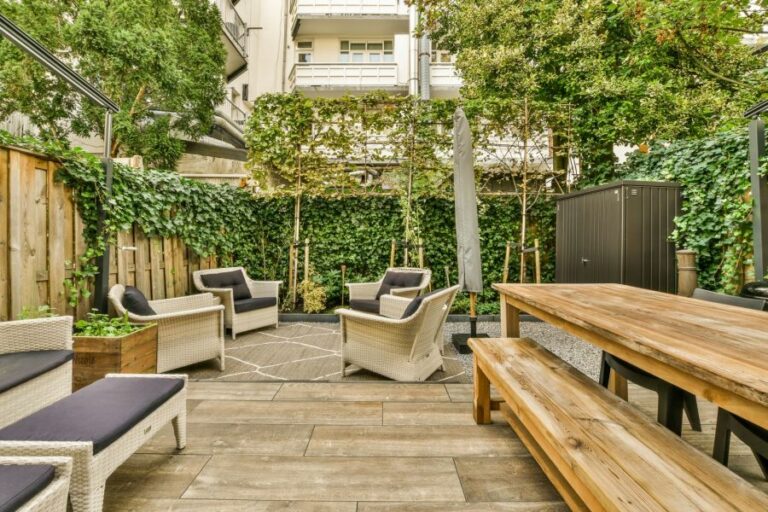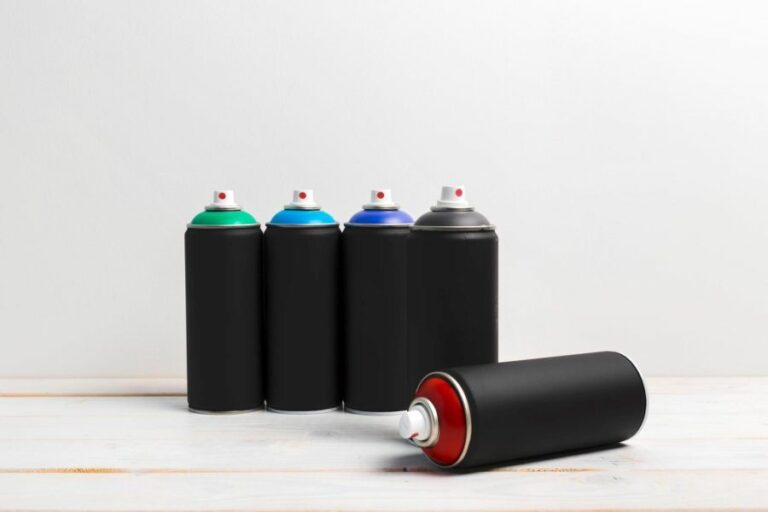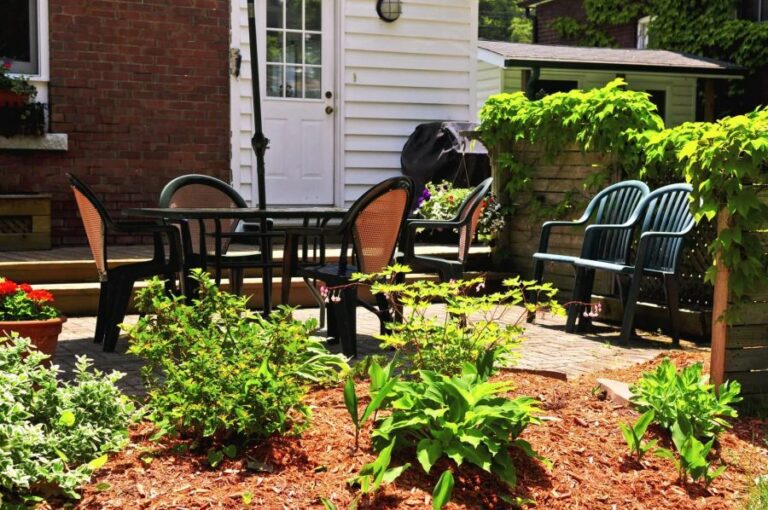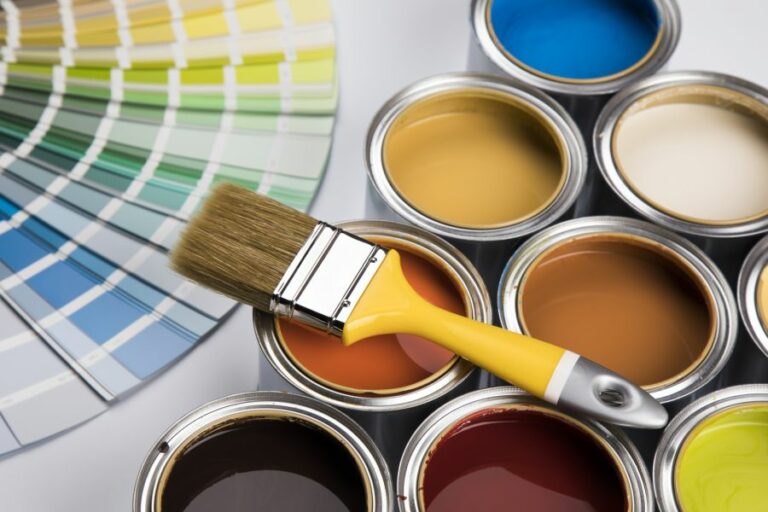Can You Use Outdoor Paint In A Bathroom. What Pros Say
Are you thinking of repurposing that leftover outdoor paint for your bathroom’s fresh look? You’re not alone! In this blog post, we will explore whether outdoor paint is a suitable choice for your bathroom walls, considering factors such as durability, moisture resistance, and overall aesthetics.
Can you use outdoor paint in a bathroom:
While outdoor paint’s durability and cleanability may seem attractive for bathroom applications, its lack of anti-microbial properties, potential health risks posed by harmful chemicals, and limited breathability make it an unsuitable choice. It is advisable to use bathroom-specific paint products that offer a balance of aesthetics and functionality while addressing unique bathroom challenges such as humidity, moisture, and mold resistance.

Discover the key differences between outdoor and indoor paints, the benefits and drawbacks of using outdoor paint in your bathroom, and expert tips for achieving a long-lasting, moisture-resistant finish that keeps your space fresh and stylish.
Contents
- 1 Is it Possible to Utilize Exterior Paint in a Bathroom Setting?
- 1.1 • Introduction: The Indoor-Outdoor Paint Dilemma
- 1.2 • Outdoor Paint: Unraveling its Intrinsic Qualities
- 1.3 • The Bathroom Conundrum: Humidity, Moisture, and Ventilation
- 1.4 • Assessing Suitability: Pros and Cons of Using Outdoor Paint in a Bathroom
- 1.5 • Conclusion: Venturing Beyond the Norm or Sticking with Convention?
- 2 Is it Acceptable to Utilize Outdoor Paint in a Bathroom Setting?
- 3 What are the consequences of utilizing exterior paint for interior applications?
- 4 Which Type of Paint Should Be Avoided in Bathroom Spaces?
- 5 What Type of Paint is Safe and Suitable for Bathroom Use?
Is it Possible to Utilize Exterior Paint in a Bathroom Setting?
• Introduction: The Indoor-Outdoor Paint Dilemma
When it comes to painting your bathroom, selecting the appropriate paint product is an indispensable step in achieving satisfactory results. With a myriad of options available, choosing between indoor and outdoor paint can leave one baffled, especially if you’re contemplating using outdoor paint indoors.
• Outdoor Paint: Unraveling its Intrinsic Qualities
Outdoor paint, or exterior paint, is deliberately formulated to combat deteriorating weather conditions and resist fading, chalking, blistering, and peeling.
This resilience is achieved by incorporating essential components such as higher resin content, elastomeric polymers, and UV-resistant additives. Let’s dissect these elements and their implications for using outdoor paint in a bathroom.
– The Role of Resin and Elastomeric Polymers
Resin fortifies paint, enabling it to meld onto surfaces and fostering adhesion. Exterior paints have a heightened resin content, which bolsters their ability to endure temperature fluctuations and constant exposure to the elements.
In contrast, indoor paints possess a more modest resin concentration, striking a balance between durability and breathability.
The integration of elastomeric polymers provides outdoor paint with exceptional elasticity, facilitating surface expansion or contraction without cracking or flaking. This quality further enhances the paint’s resistance to the rigors of exterior applications.
– UV-Resistant Additives: Defending Against Sun Damage
Exterior paints are also furnished with UV-resistant additives, which obstruct color fading and shield surfaces from the detrimental effects of sunlight. These additives contribute to the longevity and color retention of outdoor paint.
• The Bathroom Conundrum: Humidity, Moisture, and Ventilation
A pivotal aspect to consider when determining the suitability of outdoor paint in a bathroom is the environment. Bathrooms are typically subjected to elevated humidity levels, incessant moisture exposure, and insufficient ventilation.
Consequently, the paint used in this space should possess specific attributes, such as mold and mildew resistance and a propensity for easy cleaning.
– Anti-Microbial Features: Stalwart Against Mold and Mildew
Bathrooms provide a conducive environment for mold and mildew proliferation. Although outdoor paints may boast some level of mildew resistance, they fundamentally lack the built-in anti-microbial properties that bathroom-specific paints possess.
Thus, the lack of anti-microbial features could undermine the efficacy of outdoor paint in a bathroom setting.
– Cleaning and Maintenance: A Tale of Two Coatings
Exterior paints are engineered for endurance, and their unique composition ensures steadfastness against aggressive scrubbing and cleaning. Since hygiene is paramount in bathroom spaces, outdoor paint could serve as an unanticipated choice in this respect.
• Assessing Suitability: Pros and Cons of Using Outdoor Paint in a Bathroom
In light of the aforementioned points, employing outdoor paint in a bathroom presents a myriad of pros and cons. Weighing these factors is vital to making a well-informed decision.
– Pros
- Durability: Outdoor paint’s robust composition renders it resistant to wear and tear, making it a seemingly attractive option for high-traffic areas or households with children and pets.
- Cleanability: Exterior paints possess inherent resilience against rigorous cleaning, fulfilling an essential criterion for bathroom applications.
– Cons
- Potentially Harmful Chemicals: Outdoor paint may comprise chemicals, such as biocides and fungicides, that are unsuitable for enclosed spaces. Prolonged exposure could induce health hazards, especially for individuals with respiratory disorders or allergies.
- Limited Breathability: As exterior paints prioritize durability, they might not allow the walls to “breathe” efficiently, thereby heightening the risk of trapped moisture and subsequent breeding of mold.
• Conclusion: Venturing Beyond the Norm or Sticking with Convention?
Examining the pros and cons of using outdoor paint in a bathroom reveals that, while its durability and cleanability are advantageous, the potential health risks and breathability concerns make this audacious move inapt for most situations.
It’s advisable to opt for bathroom-specific paint products, which are specifically crafted to mitigate the distinct challenges that these unique spaces present. By doing so, you’ll achieve an optimal balance of aesthetics and functionality, safeguarding your bathroom sanctuary.
Aspect | Details |
|---|---|
Outdoor Paint Usage | While it is not recommended, you can technically use outdoor paint in a bathroom. However, it might not provide the best results in terms of durability, finish, and overall appearance. |
Moisture Resistance | Outdoor paint is designed to withstand harsh weather conditions and resist moisture, making it suitable for use in a bathroom. It can help protect the walls and prevent damage from moisture and humidity. |
Indoor Paint vs. Outdoor Paint | Indoor paint, specifically bathroom paint, is specifically formulated to withstand moisture and humidity, along with being more resistant to mold and mildew. It may provide a smoother finish and more suitable color options for interior use. |
Recommendation | It is best to use paint specifically designed for bathrooms or other high-moisture areas to ensure optimal results and long-lasting protection for your walls and surfaces. |
Is it Acceptable to Utilize Outdoor Paint in a Bathroom Setting?
• Delving into Paint Categories
Paints made for various applications exhibit idiosyncratic properties geared toward the environmental demands they are subjected to.
For instance, outdoor paints – oftentimes referred to as exterior paints – are fashioned to endure the rigors of Mother Nature, encapsulating a slew of resistance features against the sun’s ultraviolet radiation, moisture, mildew, and even peeling.
Conversely, indoor paints, also known as interior paints, are designed for confined spaces. These formulations frequently boast minimal odor, low chemical emissions, and easy-to-clean properties. Their inherent characteristics make them paragons of utilization within households.
As we plumb the depths of these categories, it becomes expedient to delve into whether the traits of outdoor paints render them suitable candidates for use within the restroom environment.
• Apprehending the Bathroom Environment
Sanctuaries of personal hygiene and self-care, bathrooms are unique spaces with distinguishing characteristics. These enclaves contend with high humidity levels, resulting from copious amounts of steam and water in a frequently enclosed space.
Additionally, restrooms are hotspots for mold, mildew, and fungal growth, owing to the symbiotic relationship these organisms share with moisture.
Consequently, the bathroom paint demands a degree of armament: protection against excessive humidity, resistance to water damage, mold, mildew, and the ability to endure wear and tear from regular cleaning endeavors.
• Evaluating the Suitability of Outdoor Paints for Bathrooms
Contemplating the application of outdoor paints within the restroom environment necessitates the dissection of their inherent properties. Conspicuously, outdoor paints boast high resistance to water damage, mold, mildew, and overall sturdiness.
This synchronicity of attributes lends credence to the notion that outdoor paints may, in fact, suffice in the humid, moisture-laden atmosphere of a lavatory.
However, striking a balance between the advantages and the disadvantages is essential. By their very nature, outdoor paints boast higher susceptibility to unpleasant odors and elevated levels of volatile organic compounds (VOCs).
Within the confined setting of a restroom, these qualities may lead to undesirable outcomes, such as intoxicating scents and harmful effects on indoor air quality.
• A Compromise: Paints Purposely Crafted for Bathrooms
Enter bathroom paints – formulations that straddle the line between their indoor and outdoor counterparts, specifically curated to cater to the sui generis requirements of lavatories.
These paints encompass the water, mold, mildew resistance of outdoor paints, and the low VOC content and odor levels often attributed to indoor paints.
Amenable to diverse substrates, including tiles, walls, and ceilings, these specially concocted paint formulations prove to be an ideal compromise.
Coupling unrivaled resilience and resistance with a more healthful ambiance, these paints cater to the longevity of your restroom surfaces and the sanctity of your indoor environment.
• In Conclusion: Weighing Risks and Benefits
Although applying outdoor paints in restrooms might hold a veneer of appeal, the potential negative repercussions must also be considered.
The tangible benefits of adopting bathroom-specific paint formulations far outweigh the risks posed by using outdoor paints in such an enclosed space.
With uniquely tailored properties, these paints offer the perfect balance of protection and harmony, safeguarding both the restroom surfaces and the dweller’s well-being.
What are the consequences of utilizing exterior paint for interior applications?
A common conundrum of decorators and do-it-yourself enthusiasts involves using exterior paint for interior applications.
• Disparate Paint Constituents: The Interior vs. Exterior Debate
– Interior Paint: A Sanctuary for Sophistication and Subtlety
The composition and purpose of paint largely determine its usage and interior paint is specially formulated to serve a variety of specific tasks.
The inclusion of certain ingredients such as emulsifiers, extending agents, and delicate pigments bestow upon interior paint its distinctive characteristics, making it well-suited for household environments.
With a focus on aesthetics, durability, and immersive ambiance, interior paint provides the foundation for creating captivating living spaces.
– Exterior Paint: Built to Weather the Storm
On the flip side, exterior paint exhibits a unique composition designed to perform under challenging environmental conditions.
Its amalgamation of ingredients, such as high levels of acrylic, resilient binders, and potent biocides, offers protection from constant exposure to sunlight, moisture, and fungal growth. Exterior paint boasts a robust constitution engineered to withstand an array of natural aggressors.
• The Consequences of Deviating from Design: Using Exterior Paint Indoors
A deviation from recommended specifications can yield unfortunate consequences, and the use of exterior paint in an interior setting is no exception. By deploying exterior paint indoors, the resulting issues are multifarious and potentially alarming.
– Health Hazards: The Silent Adversary
One major downside of using exterior paint indoors revolves around the health risks it may engender. Exterior paint formulations typically contain higher quantities of volatile organic compounds (VOCs), which can cause a range of health issues.
Headaches, nose and throat irritation, dizziness, and nausea are possible manifestations of VOC exposure. In severe scenarios, respiratory issues and exacerbation of asthma symptoms could arise. Consequently, utilizing exterior paint indoors may be detrimental to your well-being.
– Aesthetic Anomalies: Compromising the Cohesion of Your Home
Aesthetic appeal is a primary objective of interior design, and the use of exterior paint within your home may act counterintuitively to this goal. Due to its distinct properties, exterior paint may exhibit a sheen that clashes with the existing indoor ambiance.
This disparity could culminate in a discordant atmosphere, contrasting with the visual harmony and tranquility that many individuals aim to cultivate within their living spaces.
– Durability Dilemmas: The Uneven Erosion of Elegance
Although exterior paint boasts durability in terms of withstanding external weathering, its resilience to everyday wear and tear within the household may be suboptimal. The specific attributes that provide exterior paint its fortitude may be unsuitable for furniture and walls within your home.
Interior paint, with its targeted composition, offers superior longevity in terms of resisting chipping, peeling, and staining.
• In Summation: Prudent Paint Practices
It is unwise to substitute exterior paint for interior paint in one’s home, as the myriad potential consequences outweigh any perceived convenience.
Acknowledging the differing compositions and functionalities of paint variants is integral to crafting a visually stunning, safe, and cohesive living environment that will stand the test of time.
To achieve optimal results when decorating your home, adhere to the specifications and guidelines provided by paint manufacturers, and select paint products designed for the intended application.
By adhering to these principles, you can maintain the sanctity of your home and protect the safety and well-being of its inhabitants.
Possible Result | Description |
|---|---|
Strong Odor | Exterior paint may have a stronger odor compared to interior paint, which can be uncomfortable and may last for several days. |
Poor Finish Quality | Exterior paint may not adhere as well to interior surfaces, leading to a less smooth and less attractive finish. |
Durability Issues | Exterior paint is formulated for weather resistance and may not provide the same durability and wear resistance as interior paint for indoor use. |
Air Quality Concerns | Exterior paints may contain higher levels of volatile organic compounds (VOCs) than interior paints, which can lead to poor indoor air quality and health concerns. |
Increased Costs | Exterior paint is typically more expensive than interior paint, so using it for interior purposes may result in unnecessary additional costs. |
Which Type of Paint Should Be Avoided in Bathroom Spaces?
Gone are the days when homeowners overlooked the design and aesthetic appeal of their bathrooms. As the importance of an inviting and soothing space amplifies, bathroom walls ask for more than a mere coat of paint.
But beware! Not all types of paint will enhance the appearance and functionality of your private sanctuary.
• The Perils of Using Flat Paints: A Lesson in Moisture Resistance
While flat paints may exude an elegant charm in other areas of your dwelling, they can become your bathroom’s archenemy. Read on to comprehend the basis of this discord.
– Magnets for Mold and Mildew
Renowned for their relatively porous nature, flat paints tend to entice moisture that gives rise to mold and mildew, the nemeses of a pristine bathroom experience.
– Adverse Impact on Durability
Owing to their susceptibility to water damage, flat paints rapidly deteriorate, leaving your bathroom walls in shambles sooner than anticipated.
– Cleaning Challenges
Bathrooms, being high-traffic zones, need regular cleaning to maintain their immaculate state. However, relentless scrubbings cause flat paints to disintegrate, stripping walls of their allure.
• Why You Should Steer Clear of Eggshell and Satin Paints
While eggshell and satin finishes fare better than their flat counterparts, they aren’t immune to the perils awaiting within the confines of a bathroom.
– Insufficient Moisture Resistance
Although their velvet-like sheen showcases a modicum of moisture resistance, eggshell and satin paints still exhibit higher vulnerability when compared to glossier options.
– Abrasion Prone
Their seemingly delicate finish makes them more susceptible to scratches and chips, undermining the bathroom’s harmonious ambiance.
• Unfit for Bathroom Walls: Oil-Based Paints
Traditional oil-based paints may be a classic choice for home decor enthusiasts, but they lack essential attributes suitable for bathrooms.
– Desultory Drying Time
The protracted pace of drying that oil-based paints exhibit may disrupt your household’s daily grind while awaiting a functional bathroom.
– Perilous Fumes
Unpleasant fumes emanating from oil-based paints can infiltrate adjacent rooms, creating discomfort and possible health hazards for inhabitants.
– Environmental Hazards
Considering the detrimental consequences they inflict on the environment, oil-based paints are increasingly being supplanted by more eco-friendly options.
• Specialty Paints: A Cautionary Tale
Dazzled by the allure of unconventional paint varieties, homeowners may be tempted to experiment with their bathrooms. The following points warn against such imprudent ventures:
– Chalk Paint: An Invitation to Disaster
Although chalk paint imparts a distinctive, aged appearance to furniture, its permeable nature renders it utterly unsuitable for high-moisture environments like bathrooms.
– Metallic Paint: A Comet That Fizzles Out
The enticing glow of metallic paint may lose its sheen in a bathroom as humidity fosters corrosion and discoloration.
• The Verdict: What to Avoid in a Bathroom’s Color Palette?
To summarize our investigative foray, the types of paint to circumvent while planning your bathroom decor include:
- Flat and matte paints
- Eggshell and satin finishes
- Oil-based paints
- Specialty paints, such as chalk and metallic
In light of these recommendations, opt for more enduring and moisture-resistant paints, like semi-gloss or high-gloss finishes. In doing so, your bathroom’s walls will maintain their refined appearance and structural integrity for years to come, upholding the essence of a personal sanctuary within your home.
What Type of Paint is Safe and Suitable for Bathroom Use?
Navigating the labyrinthine world of paint options can be a daunting endeavor when selecting the ideal paint for your bathroom. As bathrooms encounter elevated humidity levels and frequent changes in temperature, it’s crucial to opt for a paint that is resilient against these environmental vicissitudes.
• A Synthesis of Durability and Elegance: The Quintessential Bathroom Paint
– Semi-Gloss Paints: Resilient and Lustrous
Semi-gloss paints represent an astute choice for bathroom applications due to their innate resistance to moisture, propensity for easy cleaning, and inherent aesthetic charm.
When pitted against their flat and matte counterparts, semi-gloss paints demonstrate superior fortitude in withstanding wear and tear, moisture, and mildew while retaining their radiant sheen.
– Satin Paints: A Harmonious Balance of Attributes
Melding gloss and matte properties, satin paints possess attributes closely resembling those of semi-gloss paints but with a slightly subtler sheen.
This fusion imbues satin paints with an admirable combination of endurance, moisture resistance, and a delicate yet stylish appearance that makes them a viable contender for bathroom walls.
– High-Gloss Paints: The Pinnacle of Protective Brilliance
As the apotheosis of reflective sheen, high-gloss paints deliver unparalleled durability and sturdiness that can endure the harshest of conditions.
While their gleaming appearance may prove too ostentatious for some, their intrinsic resilience against grime, mildew, and moisture renders them an ideal solution for baseboards, trims, and other bathroom surfaces susceptible to dampness.
• Factors to Contemplate: Determining the Optimal Paint Choice
– Intrinsic Moisture Resistance: A Vital Component
One of the paramount features of bathroom paint is its inherent ability to repel moisture. While all aforementioned options provide adequate water resistance, some excel more in this respect than others.
High-gloss and semi-gloss paints are inherently more impervious to moisture than satin paints, granting them the edge in rooms plagued by high humidity levels.
– Scrub-ability: A Testament to Tenacity
The capacity to withstand vigorous scrubbing is an invaluable trait of bathroom paint, as it allows for the facile removal of stubborn stains and grime.
Higher gloss paints are typically more amenable to this cleaning technique; however, advancements in paint technology have bolstered the scrubbability of satin paints, progressively narrowing the gap between the two options.
– Aesthetics: The Art of Ambience
An often-overlooked facet of bathroom paint selection is the impact of paint sheen on the overall ambiance of the room.
Both satin and semi-gloss paints can enhance the visual allure of a bathroom without being overly gaudy, whereas high-gloss paints can exude an opulent, glass-like effect that may prove polarizing. Ultimately, the decision rests on individual preferences and stylistic intent.
• The Final Verdict: A Blend of Durability and Visual Panache
When selecting the optimal paint for your bathroom sanctuary, it’s crucial to consider numerous factors, including the room’s innate humidity, desired maintenance level, and overall aesthetic vision.
As each paint option has its unique merits and drawbacks, a prudent selection would be a blend of durability and visual panache; semi-gloss and satin paints emerge as the most sensible choices for bathroom walls.
For areas prone to higher moisture exposure, high-gloss paints are advised to ensure comprehensive protection.


